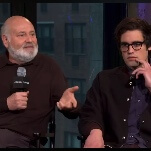Vinny Chase and a weaponized hat: 9 alternate-universe takes on The Great Gatsby
1. Ernesto Quiñonez, Bodega Dreams (2000)
Bodega Dreams, the debut novel by Ernest Quiñonez, is narrated by Chino, an ambitious striver from the Spanish Harlem section of Manhattan, who—like the author—is of Ecuadorean-Puerto Rico heritage. Chino’s dreams of getting out are dwarfed by those of the romantic demi-gangster Willie Bodega, who uses the profits from his narcotics business to seed honest local businesses and help anyone who comes to him in need of rent or tuition money or legal help. A product of a time with very different public values than those that Gatsby had to contend with, Bodega makes no effort to conceal his crooked past or his crooked present—his outlaw reputation is part of what makes him king of the street. But both his fantasy of using drug money to elevate his people, and his hopes of reuniting with his lost love, are as doomed to fail as Gatsby’s dream of turning back the clock. Quiñonez puts a spin on Gatsby’s shameful, hidden past as a bootlegger when he has Bodega proudly compare himself to Joseph P. Kennedy, getting his hands dirty for the benefit of the next generation.
2. Chris Bohjalian, The Double Bind (2007)
The heroine of Chris Bohjalian’s novel The Double Bind is Laurel Estabrook, whose aristocratic-sounding name has roots in F. Scott Fitzgerald’s masterpiece: She grew up in West Egg, the fictitious setting of The Great Gatsby. After a violent assault leaves her traumatized, Estabrook takes a job at a homeless shelter, where she meets a mentally disturbed resident who, after his death, leaves behind a cache of photos of celebrities from the 1950s and 1960s, as well as a photo of Laurel on the day she was attacked. The plot thickens with the entrance of Pamela Buchanan—the now-elderly daughter of Tom and Daisy Buchanan, who has devoted her life to tidying up her parents’ scandalous reputation, and who sees the dead man and his pictures as an inconvenience. This gimmicky, twist-ridden novel turns on the possibility that he may have been her brother, who Pamela maintains died when he was 16—and that his real father may have been you-know-who.
3. The Great Gatsby For NES (2011)
Proving that even classic works of literature can undergo the 8-bit treatment, The Great Gatsby was made into a Nintendo-esque browser game in 2011. Players control Nick Carraway as he journeys to find the titular hero, fighting off flappers and hobos. While the levels (Gatsby’s House, The Valley of Ashes, etc.) all match certain scenes from the book, Nick never had to use his hat as a weapon in the original. Interspersed through the levels are brief interactions with characters from the novel, and the levels end with cutscenes that recreate defining moments of the story. (The one depicting Gatsby looking out over the water at Daisy’s house remains heartbreaking, no matter the medium.) The website claims the game was originally released by Nintendo in Japan and never reached American shores. In fact, it’s the creation of some American programmers, who manage to do both the book and game’s console justice: The Great Gatsby is actually fun to play, armed with great in-jokes and a killer soundtrack that re-imagines ragtime as chiptune.
4. Gordon Korman, Jake, Reinvented (2003)
Considering The Great Gatsby is mandatory reading for high school sophomores everywhere, it’s not that much of a stretch to imagine the book set in an actual high school. That’s what Gordon Korman did with Jake, Reinvented, a 2003 YA novel based around the mysterious Jake Garrett, who’s new at school but throws the most bitchin’ parties. He has eyes for Didi, but she’s already spoken for by Todd Buckley. Narrator Rick oversees the whole thing, and while the premise might not sound all that creative or creatively adapted, hey, if it gets CliffsNotes-deprived high schoolers to understand the book a little better, it can’t be all bad.






















![HBO teases new Euphoria, Larry David, and much more in 2026 sizzle reel [Updated]](https://img.pastemagazine.com/wp-content/avuploads/2025/12/12100344/MixCollage-12-Dec-2025-09-56-AM-9137.jpg)

















